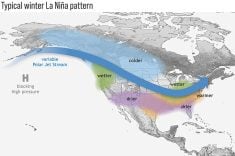LA BROQUERIE, Man. – A difficult crop year threatens to push insurance claims in Manitoba to the highest in more than a decade.
In 1993, Manitoba Crop Insurance paid out more than $105 million in claims because of a wet harvest in areas like the Red River Valley and because of fusarium head blight in cereals.
The crop insurance agency already is predicting that claims this year will surpass that level, although officials are reluctant to put out a final estimate.
A cool, wet growing season, a frost in August and a less than ideal harvest conspired against Manitoba growers this year. The damage to crops varied across the province, but many farmers saw significant losses in yield and quality, especially among specialty crops.
Read Also

Saskatchewan throne speech promises strong economy
Saskatchewan’s legislative agenda for the coming year will focus on meeting the challenges of new world trading relationships, said the speech from the throne.
“A lot of corn, beans and sunflowers, in particular, were written off in the field and destroyed,” said David Koroscil, sales and service manager for Manitoba Crop Insurance.
The damage to crops has prompted questions among some farmers about whether the insurance agency will have enough money to cover the losses. Koroscil gave assurances last week that that will not be a problem.
“There is definitely enough money to meet all the claims,” he said.
For Rudolf Hausammann, it was a year he would rather forget. As of Nov. 25, a third of his corn crop near La Broquerie was still waiting to be harvested. The corn was slow to mature because of the cool growing season and the crop was hard to harvest because of the soggy fields in his area of eastern Manitoba.
“The whole year was a struggle,” said Hausammann. “It’s like that all around here.”
The corn still standing in his fields is infected with mould and he will likely not salvage any of it for his dairy herd. His feed costs will soar this winter, partly because he got only two cuts of alfalfa this year instead of the typical three and he will need to buy grain to make up for the poor performance of his corn. Straw also is in short supply, forcing him to haul it in from as far as 200 kilometres away.
Hausammann expects he will need to make an extra two passes across his fields with a cultivator next spring to level out the ruts that resulted from this year’s wet harvest.
“I’ll have a lot of work to do in the spring to get the fields back ready.”
It was also a “very challenging” year for pulse and soybean growers, said Lincoln Wolfe, vice-president of the Manitoba Pulse Growers Association. There already is some concern that seed for planting soybeans and edible beans could in short supply.














